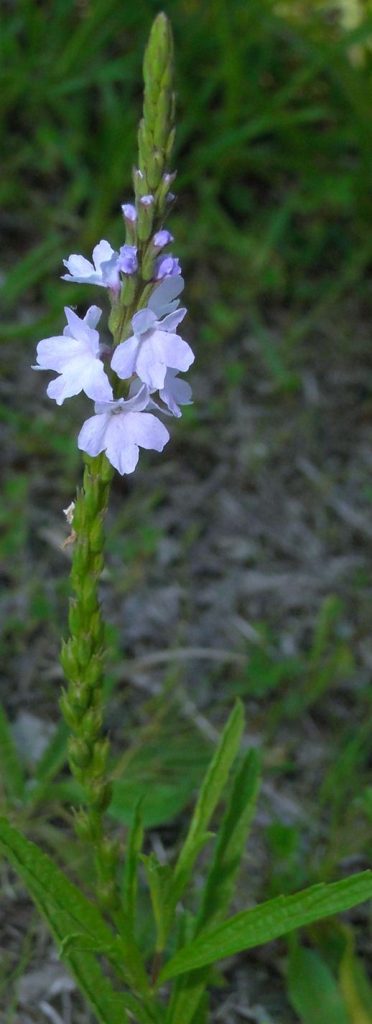A few years ago, Tom and I were having sharing a bottle of wine and talking about witchery and plants (as usual) and he looks over at the vervain growing in our garden and asks “Why vervain?” I didn’t understand his question, and so to clarify, he says “I’m wondering how it got such a wealth of magical lore associated with it.” Indeed, it is quite an unassuming plant. It lacks the dark glamoury of belladonna and datura, the bold sensuality of roses, and the uncanny lightness of mistletoe. It’s lightly scented with small flowers, yet for all its seeming normality, vervain is one of the most well known magical plants, with an abundance of lore outweighing most others.
Vervain is a hardy perennial in the genus Verbena, growing up to 3 feet high, with opposite leaves which are toothed and fairly thin growing on square stems. Small, five petelled blossoms, usually white, blue or lavender, grow on a spike (though some species bloom from a small head of flowers instead) and bloom in the height of summer. Vervain are generally drought-resistant, tolerating full to partial sun, and enjoy well-drained, average soils but can be found on limey soil or calcareous sites as well. There are over two hundred species in the genus Verbena, though many locations have a single representative that dominates–Verbena officinalis is one of the few species native to Europe, for instance. The most diversity in the genus is found in the Americas; we grow 4 species in our garden (V. hastata, V. simplex, V. bonariensis, and V. officinalis). Most of the vervains are possessed of the same subtle witchery in slightly different “flavors”. (Lemon verbena, though, is a completely different plant in a different genus.)
The genus name, as the historian Pliny tells us, refers to the Roman term verbenae, which was applied to a class of plants that was considered very powerful and featured in sacred ceremonies. Pliny also goes on to describe the uses of a plant belonging to this category known as hiera botane (or sacred plant), that the Latins called verbenaca–the noble vervain. It was one of Hippocrates favorite healing herbs, and got a reputation in the ancient world as a heal-all. Various writers in the ancient world indicate that it was used for ritual purification and as part of the rites of establishing holy altars in Greek, Roman, and Egyptian cultures, and that among the names it held in this capacity were Juno’s Tears, and Tears of Isis. Virgil mentions its magical use by and enchantress. Pliny the elder, writing in natural history, relates that vervain was one of the 4 sacred plants used by the druids, contemporary to his own time.
Pliny’s writing is also the origin of many of the harvesting taboos associated with vervain: “It must be gathered about the rising of the Dogstar, but so as not to be shone upon by sun or moon; and that honeycombs and honey must be first presented to the earth by way of expiation. They say also that a circle must be traced around it with iron, after which it must be taken up by the left hand, etc.”
Vervain’s reputation as a magical plant affording healing, protection and purification was undiminished in the medieval period. During this period it acquired the name simpler’s joy for its use in making magio-medicinal potions and preparations. The harvesting charms were Christianized, but they still address the plant with respect due such an herb of power, as you can see in this version dating from 1608:
Hallowed be thou, Vervein, as thou growest on the ground,
For in the mount of Calvary there was thou first found.
Thou healedst our Saviour Jesus Christ, and stanchedst his bleeding wound;
In the name of the Father, the Son, and the holy Ghost, I take thee from the ground
Additionally, vervain was one of the herbs of good Saint John, believed to peak in mystical power on St. John’s Eve.
It is therefore no surprise that the 19th Century folklore writers, eager to preserve a diminishing magical world, collected and described this information in detail. There is also evidence that it continued to be used in magical practice during the 1800’s; it’s one of the magical plants used in spells in Leland’s Aradia, Gospel of the Witches, and a number of references in the early 19th century mention the gathering of the plant for occult use in northern France. Perhaps these sources prompted vervain’s inclusion in the formation and practices of the modern day witchcraft movement– drawing magicians, druids, and witches alike to the holy vervain.
The ethereal grace of vervain is hard to describe, but when you observe this plant, especially at twilight, it appears as if illuminated by an inner glow. Culpeper’s Herbal (dating from the mid-1600’s) mentions that vervain is good for headaches and those who are “frantic” (among other conditions), and today the herb is often used as a nervine to calm anxious minds. As such, vervain is a wonderful plant to assist in quieting the mind and achieving trance states. Modern practitioners make use of vervain potions for the work of empowering, be this in the form of a wash for empowering magical tools and vessels, a holy sacrifice to charm the place of working, or potions to strengthen and empower the aetheric body. Finally, the inner illumination that can be observed in vervain in the fading light of day indicate its use to increase the Sight, a fact backed up by its use in soothsaying since antiquity.
Ultimately, I had no answer for Tom as to “Why vervain?” but it is definitely an herb of quiet strength and hidden power.


3 thoughts on “On Vervain”